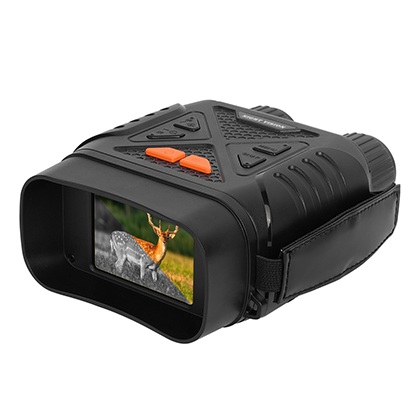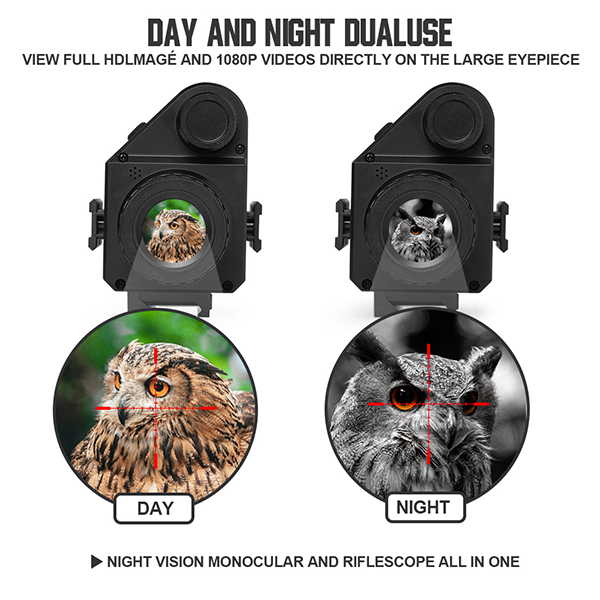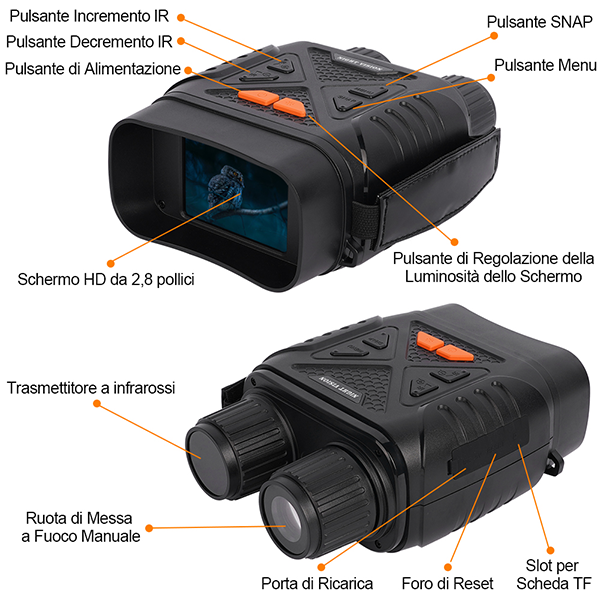Night vision devices enable users to observe and interpret surroundings in low-light or complete darkness by either amplifying available light or detecting otherwise invisible forms of radiation, such as infrared. While the concept appears straightforward at first glance, the underlying technologies differ significantly in structure, application, and visual output. From traditional image intensifiers to advanced thermal sensors and digitally processed systems, each type serves specific operational needs. This article explains how these devices function—not in abstract terminology, but in concrete, field-relevant terms—across various usage contexts, including outdoor navigation, security monitoring, emergency rescue, and tactical deployment.
A night vision device is, at its core, an optical and electronic instrument specifically engineered to improve visibility in environments with limited or no natural light. These devices are essential in tasks where human vision would be insufficient, allowing the user to identify movement, detect objects, or traverse terrain safely during night conditions.
They find widespread use among professional groups such as law enforcement units, border patrols, security personnel, military forces, wildlife researchers, and industrial inspectors. Recently, their utility has also expanded into civilian sectors—campers, hunters, offshore navigators, and homeowners are turning to night vision tools for personal safety, navigation, and recreational exploration in darkness. Despite the wide range of users, all share the same objective: transforming a dark landscape into a comprehensible visual experience.
Importantly, night vision devices are not confined to a single form factor. Some take the shape of binoculars or spotting scopes, others come as compact handheld monoculars, while certain models are purpose-built for mounting onto helmets, rifles, or vehicles. This diversity reflects the specific performance and ergonomic requirements of various operational environments—from stationary surveillance stations to fast-moving field operations.
Not every device is designed for every job. Some prioritize range and detection capability over compactness, while others offer ease of use at the expense of zoom or thermal accuracy. Some function passively, making use of whatever ambient light is available, while others actively emit infrared to generate usable imaging. To select an effective tool, one must understand how its internal mechanisms relate to real-world demands.

The image intensification process is built around one fundamental principle: amplifying the minimal amount of ambient light—often from starlight, moonlight, or surrounding artificial sources—into a visible, usable image. This is achieved through a photonic-to-electronic conversion process. Light particles (photons) enter the objective lens and strike a photocathode, which converts them into electrons. These electrons are then multiplied within a microchannel plate and finally hit a phosphor screen, which emits a visible image that the viewer can see through the eyepiece.
This method functions especially well in semi-lit environments, such as rural landscapes on a clear night or city outskirts illuminated by distant lights. The characteristic green image output seen in most night vision devices is due to the phosphor used in the intensifier tube, which is chosen for its optimal contrast with human visual sensitivity.
However, this technology has notable limitations. In environments that are completely devoid of light—such as underground tunnels or enclosed buildings—image intensifiers require external infrared illuminators to function effectively. Sudden exposure to strong light sources, such as vehicle headlights or searchlights, can also temporarily impair device performance, although higher-end models often include protective features like auto-gating to reduce image overload or blooming.
Unlike image intensification, thermal imaging operates independently of visible or near-infrared light. Instead, it relies on detecting differences in heat—or more precisely, the infrared radiation naturally emitted by all objects with a temperature above absolute zero. Human bodies, animals, vehicles, and even footprints radiate heat, all of which can be registered by the sensor array inside a thermal device.
This method offers exceptional performance in pitch-dark environments where no light exists to be amplified. Moreover, thermal imagers can penetrate obscurants such as light smoke, mist, and foliage, making them effective in environments where visual clutter or concealment may otherwise reduce detection efficiency.
Thermal images typically appear in black-and-white or multi-color gradients, depending on the palette selected. Warm objects often show up as brighter regions, while cooler backgrounds appear darker. This contrast makes it easy to detect living beings or active equipment against a cooler natural background, especially in wilderness or tactical environments.
Digital night vision devices use camera-style imaging chips—usually CMOS or CCD sensors—to capture available light, including near-infrared wavelengths. The sensor data is converted into a digital signal, which is then processed using internal software to enhance brightness, sharpen details, and reduce noise. The final image is displayed on a built-in screen, such as an LCD or OLED panel.
These systems allow for more advanced features like real-time video recording, image capture, zoom functions, and on-screen information overlays. Unlike analog systems, digital night vision is less susceptible to sudden exposure to bright light and generally more resilient in variable lighting conditions.
However, this comes with certain trade-offs. Digital sensors tend to consume more power and may deliver slightly less organic image quality compared to traditional image intensifiers in low-light conditions. Still, for many users—especially those who prioritize multi-functionality and the ability to document field activity—digital night vision offers a practical and flexible solution.

Every night vision device begins its imaging journey through the objective lens. The size, clarity, coating, and construction of this lens directly impact how much light or thermal radiation is collected. A larger aperture lens will allow more light in, thus improving brightness, but may also narrow the depth of field. Conversely, a smaller lens may provide a wider field but less brightness.
High-end lenses are typically multi-coated to reduce internal reflections and ensure that light is transmitted efficiently to the sensor or intensifier. In comparison, cheaper lenses made of plastic can introduce distortions, reduce clarity, and degrade faster under rough conditions. Selecting a well-crafted lens is essential to achieve sharp imaging across various environments.
The sensor is the device’s core processing unit. Whether it’s a microchannel plate in an image intensifier, a microbolometer in a thermal imager, or a CMOS chip in a digital system, this component is responsible for converting external signals—light or heat—into a readable format.
Different sensors offer varying levels of resolution, refresh rate, and sensitivity. Higher sensitivity improves performance in low-signal environments, but may also introduce background noise. Advanced devices often include built-in algorithms or processing software to reduce visual artifacts and improve target clarity.
Cooled thermal sensors—mostly used in high-precision military or aerospace equipment—can detect even smaller differences in heat but come with higher costs and longer startup times. For most applications, uncooled sensors provide a balance between performance and practicality.
After data capture and signal processing, the final output needs to be displayed to the user in a clear and ergonomic way. Modern night vision units employ microdisplays that are either liquid crystal (LCD) or organic light-emitting diode (OLED) screens. Each has advantages: LCDs offer cost efficiency, while OLEDs provide richer contrast and faster response times.
Some devices include customizable viewfinders with adjustable diopters or interpupillary settings, enabling users to tailor the image output to their vision requirements. Devices used in extended operations prioritize comfort and clarity in their display systems to reduce eye strain and increase accuracy during prolonged use.
More advanced units may integrate augmented display systems or wireless projection to helmets, giving users greater freedom in movement and reducing the need for direct line-of-sight viewing.

Night vision devices are available in a variety of configurations, each tailored to specific operational settings and user demands. The design choice directly influences portability, functionality, and long-term usability.
Thermal monoculars are built for agility and quick deployment. Their single-lens configuration makes them lightweight, easy to carry, and ideal for one-handed use. This makes them especially useful for mobile professionals such as forest rangers, emergency responders, and field engineers.
Most thermal monoculars allow users to switch between multiple thermal palettes—white-hot, black-hot, and color modes—enabling clearer interpretation of different environments. These devices may also include range estimators and image capture features for added utility in tactical and search-and-rescue scenarios.
Binocular systems provide dual-eye viewing, which enhances depth perception and reduces user fatigue during long observation periods. They’re favored in surveillance and wildlife applications where operators must remain stationary for hours while maintaining attention on moving targets.
Built-in IR illuminators offer variable intensity, letting users adjust brightness to suit different ranges and battery-saving modes. Integrated recording functionality adds further value, especially for researchers or security personnel who need evidence documentation.
Some models even support external display projection, making it easier to brief teams or analyze footage in real-time.
In high-mobility or hands-busy operations, helmet-mounted goggles allow users to maintain full visibility while operating equipment, driving vehicles, or maneuvering in the field. Comfort, weight distribution, and secure mounting are essential features for these systems.
Scope-based devices are optimized for precision. Designed to attach directly to rifles or spotting platforms, they often include reticle overlays, ballistic compensation features, and recoil-resistant housing. Whether for hunting or tactical engagements, these units require exact alignment and rugged durability to maintain performance under repeated use.
Every night vision technology offers advantages that make it well-suited for certain tasks—and ill-suited for others. Making the wrong choice can limit effectiveness or increase operational risk.
Thermal imaging stands out in total darkness and through environmental obstructions like light smoke or light brush. It excels at detection—spotting where someone or something is—but lacks the finer detail needed for target recognition. You can find a person, but not necessarily identify them.
Image intensification delivers better detail and a more natural visual profile. You can read signs, recognize faces, or identify gear. However, its dependency on ambient light and susceptibility to sudden brightness fluctuations make it less reliable in unpredictable conditions.
Digital night vision finds middle ground. It performs steadily across a broader range of light environments, offers digital enhancements and recording, but may lack the nuanced sharpness of analog devices in very dim scenes.
Beyond core functionality, practical considerations like battery life, weight, waterproofing, and operating temperature matter equally. There’s no universally best device—only the one that fits your setting.

Choosing the right night vision device involves evaluating several practical factors in conjunction. Consider the terrain, lighting predictability, target types, and user experience level. Someone hiking in dense forest at night will need different features than someone guarding a facility perimeter.
Thermal units work best when detection is the priority and identification is secondary. Image intensifiers perform well when visual clarity matters and some ambient light is guaranteed. Digital devices balance the two, ideal for entry-level or multi-purpose users who want features like video without extreme precision demands.
Ease of operation is also critical. Are the controls easy to locate and operate in the dark or with gloves? Is the unit simple to mount or switch between modes? These user-interface elements determine real-world reliability just as much as sensor specs.
Finally, consider power logistics. Does the user have access to charging stations? Will spare batteries be needed? In remote environments, battery strategy may dictate how long the device remains viable in the field.
Night vision devices operate through a combination of light manipulation, heat detection, and image processing technologies, each aligned with different real-world applications. Their ability to turn invisible environments into visible ones depends on the underlying imaging method—whether it’s analog, digital, or thermal. For those seeking robust and field-ready options across various operational needs, Aetronix provides a comprehensive selection of night vision solutions that deliver both reliability and performance in the environments where they matter most.
For product inquiries, reach us at cc1535@gmail.com or visit www.axoptics.com.